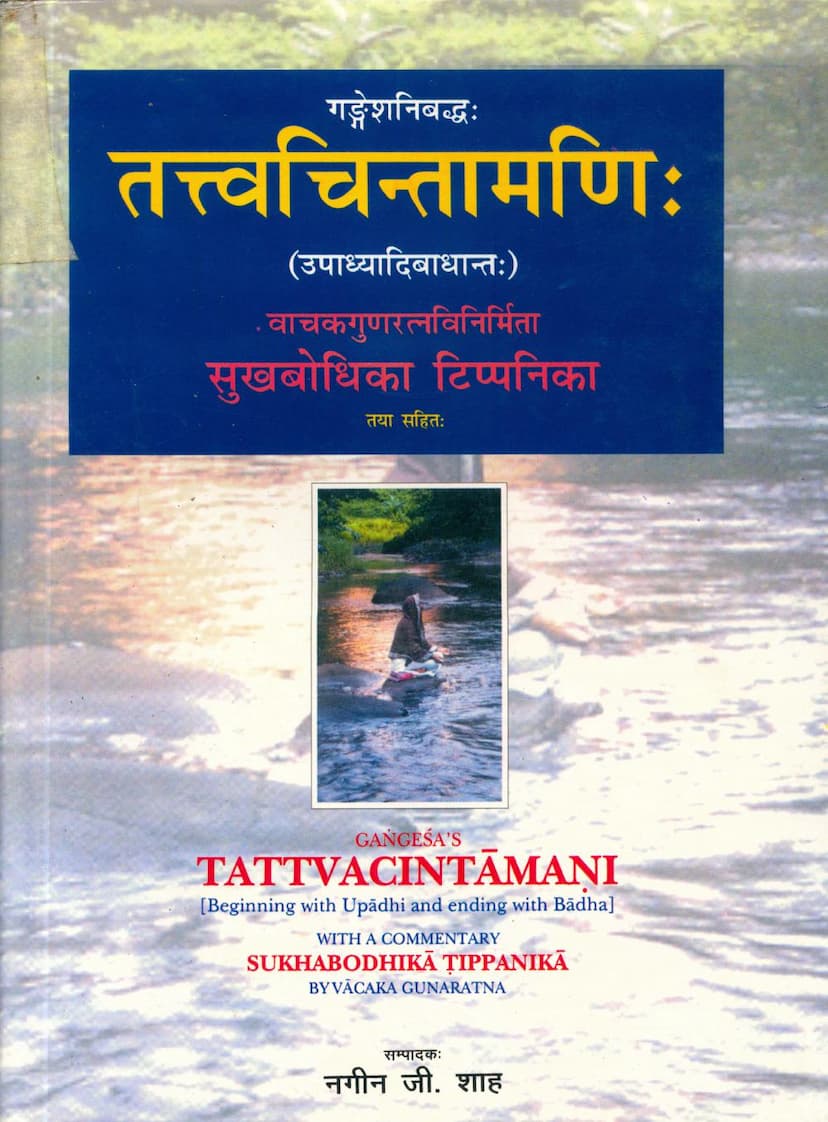Tattva Chintamani
Added to library: September 2, 2025

Summary
Here is a comprehensive summary of the Jain text "Tattva Chintamani" (Book Title: Tattva Chintamani, Author: Nagin J. Shah, Publisher: B L Institute of Indology) based on the provided pages:
Title and Author:
- Book Title: Gangesa's Tattvacintamani [Beginning with Upadhi and ending with Badha] With a Commentary Sukhabodhika Tippanika by Vacaka Gunaratna
- Author of Commentary: Vacaka Gunaratna (c. 1600 A.D.)
- Editor of the Published Work: Nagin J. Shah
- Publisher: Bhogilal Leherchand Institute of Indology, Delhi
- Series: B.L. Series No. 17
- First Edition: Delhi, 2005
Core Subject and Significance:
- The Tattvacintamani of Gangesa Upadhyaya is a foundational and highly complex work in Indian philosophy, particularly in the Navya-Nyaya system of logic. It is described as one of the most famous and difficult works of Indian philosophy.
- This publication presents the Sukhabodhika Tippanika, an hitherto unpublished commentary and subcommentary by Vacaka Gunaratna on the Tattvacintamani.
- The commentary greatly contributes to understanding this crucial philosophical text by lucidly explaining intricate points, distinguishing related concepts, discussing readings, and resolving grammatical and logical queries.
- Vacaka Gunaratna's work is seen as a positive and distinctive contribution to the vast commentarial literature on the Tattvacintamani.
Vacaka Gunaratna and his Commentary:
- Vacaka Gunaratna was a Jaina scholar from the late medieval period. The commentary, titled Sukhabodhika Tippanika, earned the adjective "Sukhabodhika" (easily understandable) due to its lucid explanations of difficult points, suggesting modesty in calling it a mere Tippanika (annotation).
- His commentary covers sections of the Tattvacintamani from Upadhi to Badha.
- Gunaratna's lineage is traced to the Kharatara Gaccha, with his teacher being Vinayasamudragani, who was a disciple of Sri Jinamanikyasuri. Jinacandrasuri, his grand-teacher, was contemporary with Hiravijayasuri (c. 1585 A.D.). Gunaratna himself completed a commentary on Kavyaprakasa in V.S. 1610 (1553 A.D.).
- The commentary is characterized by:
- Deep study and understanding of Navya-Nyaya methodology.
- Expounding subtle points and drawing fine distinctions between concepts.
- Discussing textual variations.
- Referring to and quoting authoritative authors and texts (e.g., Vatsyayana, Vacaspati Misra, Udayana, Gangesa).
- Addressing grammatical points, citing authorities like Panini.
- A significant feature is its method of raising doubts and then lucidly and convincingly answering them.
- It also includes recapitulations and summaries of discussions.
Authorship and Related Works of Vacaka Gunaratna:
- The introduction explores the identity of the author. It distinguishes him from other scholars named Gunaratna.
- Evidence suggests the author of Sukhabodhika Tippanika is the same as the author of Tarkatarangini.
- Tarkatarangini: A sub-commentary on Govardhana's Tarkaprakasika (which is a commentary on Kesava Misra's Tarkabhasa). It uses Navya-Nyaya techniques for logical and metaphysical problems, written in a simple and lucid style for students.
- Saradipika: A voluminous commentary on Kavyaprakasa, completed in V.S. 1610 (1553 A.D.), also for his monk-pupil Ratnavisala.
- Siromani-Tippana: The author of Tarkatarangini refers to a Siromani-Tippana. It is uncertain if this Sukhabodhika Tippanika is that work.
- Padarthakhandana: Gunaratna mentions this title, but it's unclear if it's his own work or a reference.
- Nyayasiddhantadipa-Tippana: The identity of the author of this commentary is debated. The editor's view leans towards the Gunaratna of Tarkatarangini and Sukhabodhika not being the author of Nyayasiddhantadipa-Tippana, based on differences in references and style.
Table of Contents (from Page 7):
The published work meticulously covers the following topics within the Tattvacintamani:
- Upadhi-vada (Doctrine of Condition/Limiting Adjunct)
- Paksha-nirupanam (Determination of the Probans)
- Paramarsa-nirupanam (Determination of Inference)
- Kevalanvayi-anumana-nirupanam (Inference which is All-Pervasive)
- Kevalavyatireki-anumana-nirupanam (Inference which is All-Exclusive)
- Arthapatti-nirupanam (Postulation)
- Avayava-nirupanam (Members of Syllogism)
- Nyaya-lakshana-nirupanam (Definition of Logic/Syllogism)
- Pratigyna-nirupanam (Statement of Thesis)
- Hetu-nirupanam (Reason)
- Udaharana-nirupanam (Example)
- Upanaya-nirupanam (Application)
- Nigamana-nirupanam (Conclusion)
- Hetvabhasam-nirupanam (Fallacies of Inference)
- Hetvabhasasamanayanirukti (General Definition of Fallacies)
- Savyabhichara (Irregular Middle)
- Viruddha (Contradictory)
- Satpratipaksa (What is later on proved un-ruly)
- Asiddhi (Unproved)
- Badha (Contradicted)
Jaina Scholars of Navya-Nyaya:
The introduction highlights that the Jaina tradition has produced few Navya-Nyaya scholars, naming:
- Gunaratnagani (14th century A.D.) - author of Tippana on Nyayasiddhantadipa.
- Bhuvanasundarasuri (c. 1390-1450 A.D.) - author of Mahavidya-vidambana-tika.
- Vacaka Gunaratnagani (16th century A.D.) - author of Tarkatarangini and the Sukhabodhika Tippanika.
- Upadhyaya Yasovijaya (18th century A.D.) - a prominent scholar of Navya-Nyaya.
Overall Purpose of the Publication:
The B.L. Institute of Indology aims to preserve ancient manuscripts, publish unpublished works, and disseminate knowledge. This publication of Gunaratna's commentary fulfills these aims by making a significant, yet previously inaccessible, work available to scholars interested in Indian philosophy and the Navya-Nyaya system.